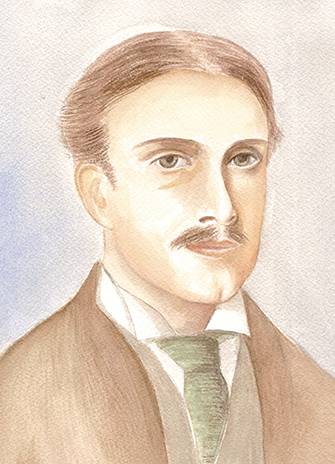When it comes to editorial projects, the 10-volume edition of The Collected Works of Walter Pater presents several special demands. For that reason, Lesley Higgins and David Latham of the Department of English, Liberal Arts and Professional Studies, have assembled a particularly rigorous, international team of editors to edit the work of the Victorian classicist, art critic and fiction writer. And they will be relying on a five-year, $170,982 Social Sciences and Humanities Research Council of Canada grant to ensure that the editors have as much professional and scholarly support possible.
The project, which they hope will be finished by 2024, will be published in hardback by Oxford University Press and then transferred to Oxford’s innovative digital humanities project, Oxford Scholarly Editions Online. One of the 10 editors works at a Danish university; two at Canadian universities; three in Britain; and four in the United States.

Pater published two novels, experimental “imaginary portraits” in prose, art criticism, classical essays, more than 75 reviews and commentaries, hundreds of letters, and left behind manuscripts that range from mere scraps to almost-finished essays that range in topics from the history of philosophy to guidelines for a thoroughly “aesthetic life.” His works are particularly interdisciplinary, Higgins explains, “but that is just the first challenge we faced. We also needed to find editors who could collate or compare accurately two or sometimes five different published versions of a text and decide which version to publish this time. And we needed to find editors who could handle Pater’s multilingual and sometimes deeply allusive writings.”
Pater (1839‒1894), from all accounts a reserved man in his public life as a Fellow of Brasenose College, Oxford, authored one of the most controversial – even notorious – books of the 1870s, The Renaissance: Studies in Art and Poetry. “The title was innocuous enough,” Latham explains, “but some of his highly poetic phrasing was misunderstood as a creed for sensual hedonism. The book’s ‘Conclusion,’ which endorses a seemingly ‘dangerous’ – because relativistic – approach to subjectivity, history, and religion (‘the perpetual weaving and unweaving of the self’), also advocated what became the by-words of the Decadent Movement.”
Specifically, Pater advised his readers to get “as many pulsations as possible into the given time”; to enjoy art and every other aspect of life with a “passion” that “yield[s] you this fruit of a quickened, multiplied consciousness”; and to seize the moment “simply for those moments’ sake.” Although Pater believed the arts are what enable us to intensify our brief lives to the fullest, the Bishop of Oxford wanted to burn the book in public, and Pater’s censorious colleagues at Oxford subsequently blocked appointments he hoped to secure.
A scholarly edition, Higgins and Latham explain, has three basic responsibilities: to bring together everything worth publishing that was produced by the author (both public and private texts); to provide entirely reliable texts (which includes determining which version published in the author’s lifetime should be the source or “copy-text” of the new volume); and to aid the reader as thoroughly as possible. The Pater edition is carefully designed for a diverse readership ranging from undergraduates reading Pater for the first time to Victorian or Pater specialists in art history, literature, classical studies, philosophy, religious studies or cultural studies.
 Mindful of the need to share with a global team their editorial and academic resources, the general editors and their research associate, Amanda Paxton (whose dissertation on Victorian poetry was awarded a Faculty of Graduate Studies dissertation prize for 2013), will be using the website (www.yorku.ca/patercw) developed by Sanja Begic, learning support technology specialist at York, and will use both the public and private domains of Orion 3, a web platform developed by the Ontario government. They are also grateful for the support of the new digital humanities division of York’s libraries.
Mindful of the need to share with a global team their editorial and academic resources, the general editors and their research associate, Amanda Paxton (whose dissertation on Victorian poetry was awarded a Faculty of Graduate Studies dissertation prize for 2013), will be using the website (www.yorku.ca/patercw) developed by Sanja Begic, learning support technology specialist at York, and will use both the public and private domains of Orion 3, a web platform developed by the Ontario government. They are also grateful for the support of the new digital humanities division of York’s libraries.
Although both Higgins and Latham have extensive experience as literary editors and textual critics, they thought twice about taking on such a complex and multi-volume project. “We realized that the Collected Works of Pater was too important to let it go to another university,” says Latham. “Pater is an author whose writings lie at the intersections of art and philosophy, of English and classical literature, and thus express the kind of interdisciplinary work that many of us at York have been promoting.”
Both Higgins, the deputy editor of The Pater Newsletter, and Latham, the editor of the Journal of Pre-Raphaelite Studies, are very involved with the Victorian Studies Network at York (VSNY). They hope that the Collected Works of Walter Pater, along with the G.M. Hopkins and the John Tyndall editorial projects and other ongoing Victorian-related research endeavours at the university, will further promote York as a centre of excellence in the field of Victorian studies.
Latham will be presenting an overview of the Pater project and its editorial challenges as part of the 7th annual VSNY symposium on Friday, Oct. 24. For more information about the symposium, see the VSNY website.


